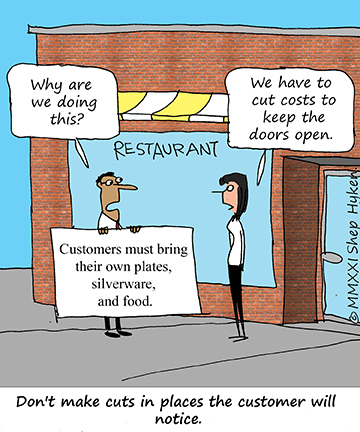Donât Cut What Is Obvious to the Customerâ¯â¯
 Last week I covered the concept of skimpflation. In case you missed it, the short definition is that skimpflation is the result of a labor shortage, some say due to The Great Resignation, and higher business costs that come from inflation and supply and demand issues. This translates to the customer experiencing a lower level of service, and in some cases, quality. Our colleague at Shepard Presentations refers to it as customer service on a diet.Â
Last week I covered the concept of skimpflation. In case you missed it, the short definition is that skimpflation is the result of a labor shortage, some say due to The Great Resignation, and higher business costs that come from inflation and supply and demand issues. This translates to the customer experiencing a lower level of service, and in some cases, quality. Our colleague at Shepard Presentations refers to it as customer service on a diet.Â
Unfortunately, customers in both the B2C and B2B worlds are not having the experiences theyâve come to expect from some of the companies they enjoy doing business with. Companies are forced to skimp on quality and service, and that is causing frustration at all levels. Customers donât like it. The leaders at these companies donât like it either. And employees, at least the ones who are still there, often have to take the brunt of their customersâ frustrations.Â
I keep wondering, whatâs the answer? How can companies work around skimpflation? Unfortunately, I donât have the perfect answer, but I do have an idea to avoid a big part of the problem, which is how the customer experience is being impacted.Â
Before sharing that idea, hereâs a quick, but important observation and a couple of examples. Iâm seeing that customer loyalty is up for grabs. In our research, we see customers demanding a great experience in exchange for their repeat business. Let them down, and they move on. The companies that still get this right are flourishing. Laggards are struggling at keeping both customers and employees. And skimpflation is whatâs causing the problem.Â
For example, you may have to pay more to keep your employees. This may force you to cut some employees to make up the cost difference. I hate that that would happen at all, but if you cut employees on the front line, thereâs a good chance your customers will notice. A bad experience or two, and the customers wonât come back.Â
I wrote about this example a few years ago. I went to a restaurant and ordered a popular dish, but that night it tasted different, as in ânot as good as usual.â I mentioned it to the manager and the explanation was that food costs had gone up and they were forced to substitute different â as in less expensive â ingredients. Obviously, it impacted the quality and taste of the food. Iâm not the only one who noticed. Cutting the quality of any of your products could cause customers to notice and seek out the competition, hoping for something better. Â
So here is my idea. Many businesses have to make cuts and concessions. They donât have a choice, but they do have a choice about where they cut. So, try not to cut in places the customer will notice. Â
It sounds simple, but that doesnât mean itâs easy. Itâs not. Some may even say itâs not realistic. So, hereâs a way to start. Gather your team and brainstorm the answer to this simple question: âWhere can we cut costs that our customers wonât notice?â You never know. Someone may have the perfect answer! Â
Shep Hyken is a customer service expert, keynote speaker, and New York Times, bestselling business author. For information on The Customer Focus customer service training programs, go to www.thecustomerfocus.com. Follow on Twitter: @Hyken
customer service training programs, go to www.thecustomerfocus.com. Follow on Twitter: @Hyken
(Copyright © MMXXI, Shep Hyken)
The post Donât Cut What Is Obvious to the Customerâ¯â¯ appeared first on Shep Hyken.



